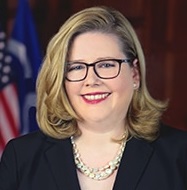
Exclusive
How GSA’s customers are driving schedule modernization efforts
Alan Thomas, the commissioner of GSA’s Federal Acquisition Service, said the agency’s value to their customers is increasing according to a recent survey.
The General Services Administration wants its agency and industry customers to know they are listening when it comes to the schedules contracting program.
Not only is the Federal Acquisition Service in the final stages of updating the schedule contracts to make it easier for agencies to buy products and services at the same time, but FAS is planning other major changes for 2019.
Alan Thomas, the commissioner of GSA’s Federal Acquisition Service, said in an exclusive interview, agency customers and industry partners are, in many ways, driving the schedules modernization strategy.
“The schedules program is still a flagship program at GSA. It’s one of the crown jewels in the franchise at the Federal Acquisition Service. We take the health of the schedules program seriously and we are actively promoting it,” he said. “We do a customer satisfaction survey every year. We got more than 13,000 responses this year and they tend to be heavily focused in the general supplies and services portfolio in terms of the users that respond to it. Overall, the results of the survey were pretty heartening. We heard from customers that the value they perceive GSA providing is up year-over-year. One of my favorite measures is when asked if GSA has their best interests, that is up as well, which I think is a good sign.”
Thomas said he’s been to all the regions once and about half a second time to meet with GSA and federal agency customers since he took over as commissioner 14 months ago.
“I got a lot of individual data points with the customers and it’s really gratifying to hear them talk about GSA’s people. That’s the thing they complement the most,” he said. “I get some feedback in terms of room for improvement on processes and systems so things like minimum order quantities and the usability of GSA Advantage are things we bring back and work on across the organization.”
One of those things GSA has been working toward is the change in the schedules program to let agencies combine products and services under one buy. Commonly known as order level materials (OLMs) or other direct costs (ODCs), this modification has been a long time in coming, and has been particularly frustrating for vendors who sell both products and services. Thomas said the impact of this major change will be felt in fiscal 2019. But, Thomas quickly pointed out that vendors and agency buyers can take advantage of the change today.
“There is a contract modification and special item number that vendors will have to get added to their contracts,” he said. “There is training and awareness. We have to make industry aware of it. We have to make our workforce aware of it, and then make the broader acquisition workforce aware of it. This is new and different so we want to make sure we get the guidance and training out.”
GSA to change minimum order requirement?
Another major change is around eliminating minimum purchase thresholds. Thomas said that was another request from agency customers because sometimes you just need to buy one of something and not 10.
“We consistently hear from customers that minimum order quantities often times will lead them to cancel orders,” Thomas said. “We are working with vendors on schedule to try and reduce or in some cases remove those minimum order quantities. Customers may be willing to pay a little more for that unit.”
Overall, Thomas said the health of the schedules is strong. He said GSA expects the schedules program to break even before they reinvest in the business, but will be in the black after investments.
“We are on a trajectory to be at break even at the level when we include our investments hopefully in two years. That’s a goal I’ve set for the organization,” he said. “Schedules spending is pretty steady over the last several years. Some of the volume has moved to governmentwide acquisition contracts and governmentwide multiple award contracts. But from my perspective, I take a portfolio approach and we want to make sure we capture all the spend that’s appropriate and having it placed on the right vehicle. But I’d say schedule spend is steady and from a cost recovery perspective, the program is healthy.”
Thomas said 2019 also is shaping up to bring major changes to the schedules program.
He said FAS is considering consolidating schedules down to one or a smaller set of schedule contracts.
“We have an internal team that is looking at that made up of a cross section of folks from FAS and they eventually will come to a set of options, they will brief up to me and we eventually will take them to [GSA Administrator] Emily [Murphy],” Thomas said. “The impetus behind schedules reform is to make sure the program continues to be healthy and meets the needs of our customers and industry partners. If you are a customer and you are looking to buy through the schedules, from our perspective sometimes it’s a little challenging to think about what schedule should they be buying it off of? Take contact centers, is that an IT purchase off of Schedule 70 or is that a professional services purchase off of 00CORP? I don’t know. I can make an argument for either.”
Thomas said he wants to reduce any potential or real confusion for agency customers as well as lessen the burden on vndors having to manage multiple schedules.
He said the working group should have some recommendations on potential schedule consolidations by the end of 2018 with implementation coming in late 2019 or 2020.
Schedule transparency pilot to launch
Additionally, Thomas said FAS is looking at whether it needs to reduce the number of contractors on the schedules, particularly those who haven’t done any sales in two or more years.
Thomas said many of these changes will need to be vetted and discussed with agency and industry partners before any implementation, which also is part of how FAS is trying to be more customer focused.
Latest Technology News
Two other major changes coming to the schedules are around transparency and fee adjustments.
Transparency has long been a problem for non-schedule holders. If you can’t see what agencies are buying through request for quotes or task orders, then how can a vendor determine whether or not to get a schedule contract — which can cost tens of thousands of dollars in time and money?
Murphy said in May that FAS would launch an e-Buy pilot in 2019 to provide more transparency into the schedules program.
Thomas said FAS Region 7 and Office of Administrative Services, which handles all the internal procurements for GSA, will take part in the pilot by making the full statement of work available on FedBizOpps.gov after the award is made.
Around the fees of the schedules program, it’s been 15 years since GSA reduced the industrial funding fee to 0.75 percent from 1 percent.
GSA and the Office of Personnel Management in August cut the fee to use the Human Capital and Training Solutions (HCATS) GWAC contract by 60 percent to 0.75 percent from 2 percent.
“We have a group that is looking at pricing [fee structure] across all of our GWACs and schedules. We want clarity and consistency for customers. We don’t want customers making choices for which vehicle to use based on the contract access fee. We want them thinking about what does the statement of work say and what is the appropriate scope of the contract? Then, making the decision based on that. In some sense, harmonizing fees or bringing them more in line with each other and making them more clear and consistent is a good move.”
GSA, VA to collaborate
A final area where GSA is trying to reduce confusion of agency customers and industry partners is around medical supplies.
The Veterans Affairs Department long has run its own medical supplies and services contracts, commonly referred to as schedules, despite GSA also running a similar program for the rest of government.
Thomas said GSA and VA are discussing how the two agencies could improve collaboration across the similar contracts.
He said VA is looking at how it could use some of the technology that GSA uses to manage its schedule program as well as how VA could use GSA’s global supply program to gain more control, visibility and more efficiencies in its micro-purchase spending.
“We are much further down the path [with the global supply program], joint teams have been stood up and projects plans have been put in place. We think in fiscal 2019 you will see some significant spend flow through that requisition channel from VA,” Thomas said.
Copyright © 2024 Federal News Network. All rights reserved. This website is not intended for users located within the European Economic Area.
Jason Miller is executive editor of Federal News Network and directs news coverage on the people, policy and programs of the federal government.
Follow @jmillerWFED
Related Stories

GSA says rule change will simplify Schedule buys, reduce proliferation of multiple-award contracts






